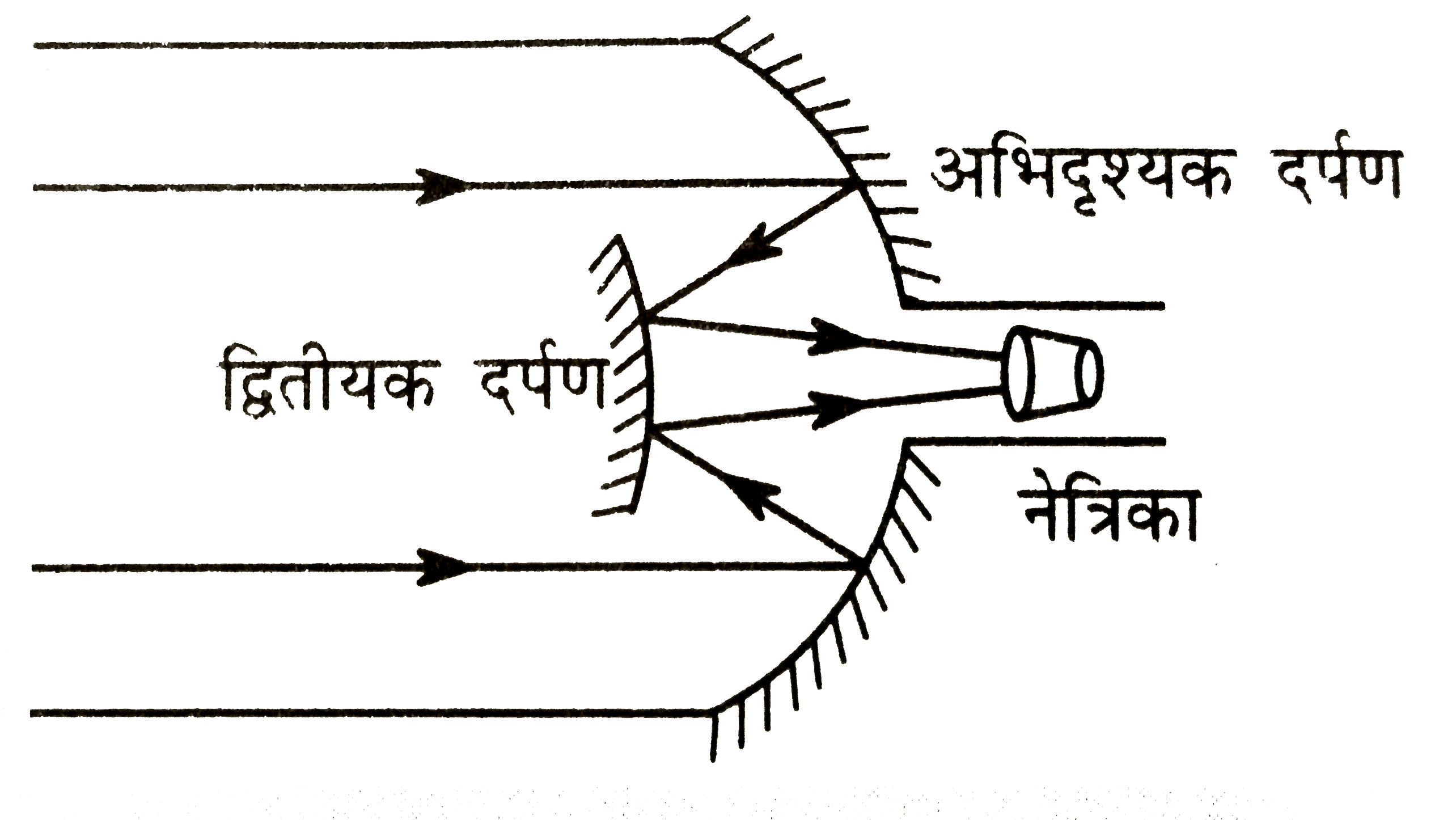A Cassegrainian telescope uses two mirrors as shown in Fig. Such a telescope is built with the mirrors 20mm apart. If the radius of curvature of large mirror is 220mm and the small mirror is 40mm, where will the final image of an object at infinity be ?
 Solution in Tamil
Solution in Tamil
The image formed by the larger (concave) mirror acts as virtual object for the smaller (convex) mirror. Parallel rays coming from the object at infinity will focus at a distance of 110 mm from the larger mirror. The distance of virtual object for the smaller mirror =(110−20)=90mm. The focal length of smaller mirror is 70 mm. Using the mirror formula, image is formed at 315 mm from the smaller mirror.
Topper's Solved these Questions
- RAY OPTICS AND OPTICAL INSTRUMENTSBOOK - NCERT TAMILCHAPTER - RAY OPTICS AND OPTICAL INSTRUMENTSEXERCISE - EXERCISES
40 Videos
- OPTICSBOOK - NCERT TAMILCHAPTER - OPTICSEXERCISE - EVALUATION (Numerical Problems)
10 Videos
- RECENT DEVELOPMENTS IN PHYSICS BOOK - NCERT TAMILCHAPTER - RECENT DEVELOPMENTS IN PHYSICS EXERCISE - Evaluation (I. Multiple Choice Questions)
10 Videos
Similar Questions
A small candle 2.5cm in size is placed 27cm in front of a concave mirror of radius of curvature 36cm. At what distance from the mirror should a screen be placed in order to receive a sharp image ? Describe the nature and size of the image. If the candle is moved closer to the mirror, how would the screen have to be moved ?
View SolutionAn object is placed at a certain distance from a convex lens of focal length 20 cm. Find the distance of the object if the image obtained is magnified 4 times.
View SolutionThe particle size of ZnO material is 30 nm. Based on the dimension it is classified as
View SolutionA Cassegrainian telescope uses two mirrors as shown in Fig. Such a telescope is built with the mirrors 20mm apart. If the radius of curvature of large mirror is 220mm and the small mirror is 40mm, where will the final image of an object at infinity be ?

View SolutionAn object is 100 mm in front of a concave mirror which produces an upright image (erect image). The radius of curvature of the mirror is :
View SolutionAn object is placed at a large distance in front of a concave mirror of radius of curvature 40 cm. The image will be formed in front of the mirror at a distance of :
View Solutionएक अवतल दर्पण की वक्रता-त्रिज्या 20 सेमी है। कोई वस्तु अवतल दर्पण से 15 सेमी की दुरी पर है। दर्पण से वस्तु के प्रतिबिम्ब की दुरी ज्ञात कीजिए।
View Solutionकिसी कैसेग्रेन दूरबीन में चित्र में दर्शाए अनुसार दो दर्पणों का प्रयोग किया गया है| इस दूरबीन में दोनों दर्पण एक-दूसरे से 20 सेमीo दूर रखे गए है |यदि बड़े दर्पण की वक्रता त्रिज्या 220 मिमीo हो तथा छोटे दर्पण की वक्रता त्रिज्या 140 मिमीo हो तो अनन्त पर रखे किसी बिम्ब का अन्तिम प्रतिबिम्ब कहाँ बनेगा ?

View SolutionA cassegrain telescope is built with the mirrors 20 mm apart. If the radius of curvature of the larger mirror is 220 mm and the small mirror is 140 mm. where will the final image of an object at infinity be ?
View Solutionकिसी कैसेग्रेन दूरबीन में चित्र में दर्शाए अनुसार दो दर्पणों का प्रयोग किया गया है । इस दूरबीन में दोनों दर्पण एक -दूसरे से 7cm दूर रखे गए हैं। यदि बड़े दर्पण की वक्रता -त्रिज्या 22cm तथा छोटे दर्पण की वक्रता -त्रिज्या 14cm हो ,तो अन्नत पर रखे किसी बिंब का अंतिम प्रतिबिंब कहाँ बनेगा ?

View SolutionA Cassegrain telescope is built with mirrors 20 mm apart. If the radius of curvature of the large mirror is 220 mm and the small mirror is 140 mm, then where will the final image of an object at infinty be?
View Solutionकिसी कैसेग्रेन दूरबीन में दर्शाए अनुसार दो दर्पणों का प्रयोग किया गया है | इस दूरबीन में दोनों दर्पण एक - दूसरे से 20mm दूर रखे गए है | यदि बड़े दर्पण की वक्रता त्रिज्या 220mm हो तथा छोटे दर्पण की वक्रता त्रिज्या 140mm हो तो अनंत पर रखे किसी बिंब का अंतिम प्रतिबिंब कहाँ बनेगा ?
View SolutionA Cassegrain telescope uses two mirrors of radii of curvature 220 mm and 140 mm. The distance b/w the two mirrors is 20 mm. Where will the final image of an object at infinity be?
View SolutionA Cassegrain telescope uses two mirrors. Such a telescope is bult with the mirrors 20mm apart. If the radius of carvature of the large mirror is 220mm and the small mirror is 140 mm, where will the final image of an object at infinity be ?
View SolutionIn a Cassegrainian telescope, ……………………. is a large concave mirror.
View SolutionA Cassegrain telescope uses two mirrors as shown in Fig. 9.30. Such a telescope is built with the mirrors 20mm apart. If the radius of curvature of the large mirror is 220mm and the small mirror is 140mm, where will the final image of an object at infinity be?
View Solution
